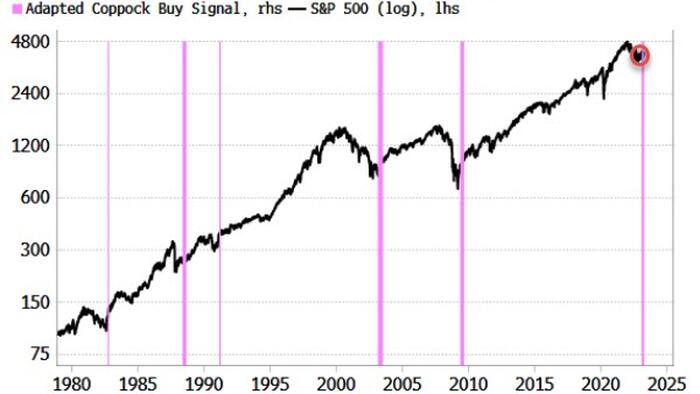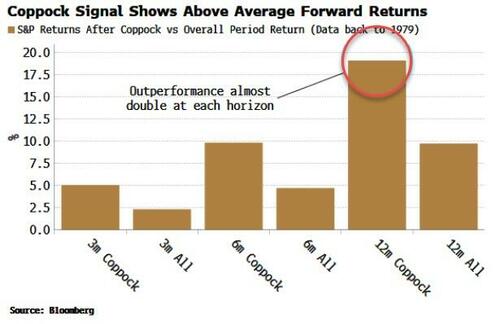


Authored by Simon White, Bloomberg macro strategist,
A purely price-based signal suggests the bottom is in for stocks despite several lingering risks.
This is a hard column to write. Deposit flight, poor liquidity, weakening earnings, a credit crunch, recession – it would be much easier to list reasons why equities should be lower.
But that doesn’t necessarily mean it will be so. As anyone who has spent enough time in markets understands, they have a habit of being “anti-utilitarian”: causing the most people the maximum amount of pain.
It thus always pays to consider the other side of the case. But even with the best will in the world, it’s hard to fully let go of one’s biases. That’s why technical analysis can be so powerful.
Some call it voodoo, but using market data to identify trends is as old as economics, dating from the 18th century when Japanese rice traders used candlestick patterns to predict price movements.
Recently, one very rare, technical-based buy signal called the Coppock has triggered, suggesting the long-term outlook for US stocks is constructive, and the bottom is potentially already in.
The Coppock is at base a momentum oscillator, which triggers when medium and longer-term measures of momentum begin to turn up on a persistent basis.
Based on adapted parameters, it triggers only rarely, but the times when it has done – e.g. October 1982, August 1988, April 2003, August 2009 – are a catalogue of generationally good buying opportunities. It outperforms the average S&P return over 3-month, 6-month and 12-month horizons, with the greatest absolute outperformance over 12 months (19.1% versus 9.7%).
The great appeal of technical signals is their simplicity. The Coppock uses only the S&P’s closing price on a daily basis. No economic data, no political inferences, no opinion – it is fixed and unemotional.
This also means signals such as the Coppock can trigger at very counter-intuitive times – a signature of contriarianism and a hallmark of many of the best buying opportunities.
The Coppock has previously triggered well before the Fed had started to hike again, when the ISM was under 50, and while the unemployment rate was rising. As the signal is not trying pick absolute bottoms, the S&P is generally already off its recent lows.
Similarly, today does not appear to be a good time to buy with economic data weakening and credit tightening, but if we were to listen only to the signal it is telling us to “buy and close your eyes”.
Another reliable signal, the Zweig Thrust, has also recently triggered. The Zweig activates more often and has more false positives than the Coppock, but it is a good gauge of the medium-term trend of the market.
The signal goes off whenever breadth (defined as the net number of stocks rising on the NYSE) rapidly goes from being very weak to very strong (i.e. “thrusts” higher). It shows good, above-average returns over the next one, three and six months.
If technical signals’ strength is their simplicity, it is also their weakness. No trader or investor could ever take a decision based purely on them (unless part of a more sophisticated quant strategy). It would be tricky, to say the least, to explain to a client or your CIO that you went long purely because one arbitrary moving average passed above another.
On the other hand, it pays to incorporate them into one’s view. In today’s case, the message is that despite everything pointing toward weaker stocks, the price action is whispering that that just might be wrong.
As already said, this was a hard column to write, and stocks could very well go on to make new lows before they exceed last year’s high. But great buying opportunities only look elementary in retrospect, and it would be remiss not to point out that this may be one of them.



